《臺灣華語教學研究》(Taiwan Journal of Chinese as a Second Language)為學術研究型期刊,由台灣華語文教學學會發行。本刊歡迎語言教學、語言習得、語言本體研究、語言應用研究等相關內容的中、英文稿件。
在學界諸多學者努力促成下,本刊於2010年發行創刊號,每年於六月與十二月發行。本刊新任總編輯為謝佳玲教授,編輯委員由世界各地的學者專家組成,其中三分之一為國際委員,海外稿件佔半數,是華語教學領域中極具國際視野的期刊。
本刊獲科技部人文社會科學研究中心肯定,2012年至2015年收錄為臺灣人文學引文索引核心期刊(THCI Core),2016年至2019年收錄為臺灣人文學期刊(THCI)。感謝各方華語先進對本刊的支持與愛護,本刊將持續深耕全球華語教學的研究,歡迎海內外學者與專家踴躍賜稿。
投稿須知:
- 以電子郵件方式投稿至本刊信箱:tjcsl@ntnu.edu.tw ,來信請註明:投稿《臺灣華語教學研究》。
- 本刊採雙向匿名審稿制度,接受中英文稿件,稿件須未曾投稿至其他刊物或在其他地方出版。
- 論文內文不得出現任何可辨識作者身份的文字,投稿時請填寫並另附作者資料表https://tinyurl.com/y493amfa,請務必填寫論文中英文標題,作者中英文全名,任職單位及聯絡方式。
- 投稿文章電子檔為MS WORD格式,文長不超過兩萬字,須附中英文摘要(約四分之一頁至半頁)及中英文關鍵詞(六個以內)。稿件格式與書目格式請參考:https://reurl.cc/L00A0X。
- 詳細投稿須知請參考本刊網頁:http://www.atcsl.org/blog/atcsl-tjcsl/。
《臺灣華語教學研究》
2021年1月20日
